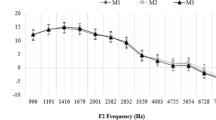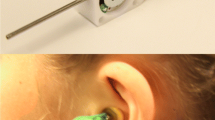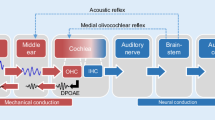Abstract
Distortion product otoacoustic emissions are one form of evoked otoacoustic emissions. DPOAEs provide the frequency specific information about the hearing status in mid and high frequency regions. But in most screening protocols TEOAEs are preferred as it requires less time compared to DPOAE. This is because, in DPOAE each stimulus is presented one after the other and responses are analyzed. Grason and Stadler Incorporation 60 (GSI-60) offer simultaneous presentation of four sets of primary tones at a time and checks for the DPOAE. In this mode of presentation, all the pairs are presented at a time and following that response is extracted separately whereas, in sequential mode primaries are presented in orderly fashion one after the other. In this article simultaneous and sequential protocols were used to compare the Distortion product otoacoustic emission amplitude, noise floor and administration time in individuals with normal hearing and mild sensori-neural (SN) hearing loss. In simultaneous protocols four sets of primary tones (i.e. 8 tones) were presented together whereas, in sequential presentation mode one set of primary tones was presented each time. Simultaneous protocol was completed in less than half the time required for the completion of sequential protocol. Two techniques yielded similar results at frequencies above 1000 Hz only in normal hearing group. In SN hearing loss group simultaneous presentation yielded signifi cantly higher noise floors and distortion product amplitudes. This result challenges the use of simultaneous presentation technique in neonatal hearing screening programmes and on other pathologies. This discrepancy between two protocols may be due to some changes in biomechanical process in the cochlear and/or due to higher distortion/noise produced by the system during the simultaneous presentation mode.
Similar content being viewed by others
References
Losbury-Martin BL, Martin GK (1990) The clinical utility of distortion product otoacoustic emissions. Ear Hear 11: 144–154
Beattie RC (2003) Distortion product otoacoustic emissions: Comparison of sequential versus simultaneous presentation of primary-tone pairs. J Am Acad Audiol 4:471–483
Gaskill SA, Brown AM (1990) The behavior of the acoustic distortion product, 2f1-f2, from the human ear and its relation to auditory sensitivity. J Acoust Soc Am 88:821–839
Hauser R, Probust R (1991) The influence of systematic primary tone level variation L2-L1 on the acoustic distortion product emission 2F1-F2 in normal human ears. J Acoust Soc Am 89:280–229
Beattie BC, Jones RL (1998) Effects of relative levels of the primary tones on distortion product emissions in normalhearing subjects. Audiol 37:187–197
Grason-Stadler. Grason-Stadler GSI-60 DPOAE — Distortion Product Otoacoustic Emmisions System User Manual. 1996; Milford NH: GSI Grason Stadler
Kim DO, Sun SM, Jung MD, Leonard G (1997) A new method of measuring distortion product otoacoustic emissions using multiple tone pairs: study of human adults. Ear Hear 18:277–284
Painter J (1997) Basic instrumentation issues in acquiring distortion product otoacoustic emmisons. In: Robinette MS, and Glattke TJ, editors. Otoacoustic Emissions. NY: Thieme; p 333–346
Painter J (2000) Grason-Stadler Incorporated (GSI). In: Hall JW, editor. Handbook of otoacoutic Emissions. San Diego CA: Singlular Publishing Group; p. 291–303
Hall JW (2000) Handbook of Otoacoustic Emissions. San Diego, CA: Singular Publishing Group
Kim DO, Zurek PM, Clark WW (1981) Ear-canal acoustic distortion products (2f1-f2) and 2f2-f1) can be suppressed or enhanced by a third tone. J Acoust Soc of Am 69:S51
Kummer P, Janssen T, Arnold W (1995) Suppression tuning characteristics of the 2f1–f2 distortion product otoacoustic emissions in humans. J Acoust Soc of Am 98:197–210
Schairer KS, Clukey C, Gould HJ (2000) Distortion product otoacoustic emissions to single and simultaneous tone pairs. J Am Acad Audiol 11:411–417
Beattie RC, Ireland A (2000) Effects of sample size on the noise floor and distortion product otoacoustic emissions. Scand Audiol 29:93–102
Author information
Authors and Affiliations
Corresponding author
Rights and permissions
About this article
Cite this article
Kumar, U.A., Maruthy, S. & Chandrakant, V. Distortion product otoacoustic emissions: comparison of sequential vs. simultaneous presentation of primary tones. Indian J Otolaryngol Head Neck Surg 61, 30–35 (2009). https://doi.org/10.1007/s12070-009-0030-8
Published:
Issue Date:
DOI: https://doi.org/10.1007/s12070-009-0030-8




